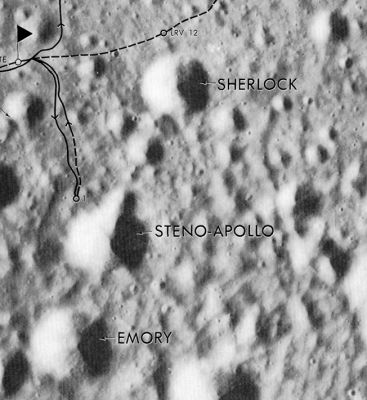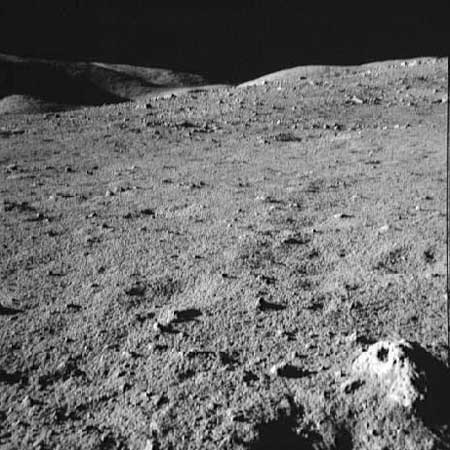Difference between revisions of "Steno-Apollo"
| Line 6: | Line 6: | ||
|} | |} | ||
[http://www.lpod.org/coppermine/albums/userpics/Apollo_17_Landing_site_craters_2.JPG [[Image:normal_Apollo_17_Landing_site_craters_2.JPG|external image normal_Apollo_17_Landing_site_craters_2.JPG]]][http://www.lpi.usra.edu/resources/apollo/images/browse/AS17/136/20769.jpg [[Image:20769.jpg|external image 20769.jpg]]]<br /> <div id="toc"> | [http://www.lpod.org/coppermine/albums/userpics/Apollo_17_Landing_site_craters_2.JPG [[Image:normal_Apollo_17_Landing_site_craters_2.JPG|external image normal_Apollo_17_Landing_site_craters_2.JPG]]][http://www.lpi.usra.edu/resources/apollo/images/browse/AS17/136/20769.jpg [[Image:20769.jpg|external image 20769.jpg]]]<br /> <div id="toc"> | ||
| − | + | Left: Aerial view from ''[http://lpod.org/coppermine/displayimage.php?pos=-2258 Apollo 17 Site Traverses Chart]''; Right: The north rim of '''Steno-Apollo''', in the middle distance, as viewed from '''Station 1''': ''[http://www.lpi.usra.edu/resources/apollo/frame/?AS17-136-20769 Apollo Image Atlas]''.<br /> <br /> | |
| − | |||
==Images== | ==Images== | ||
[http://www.lpod.org/coppermine/thumbnails.php?album=search&type=full&search=Steno-Apollo LPOD Photo Gallery] [http://www.lpi.usra.edu/resources/lunar_orbiter/bin/srch_nam.shtml?Apollo%2017%7C0 Lunar Orbiter Images] [http://www.lpi.usra.edu/resources/apollo/search/feature/?feature=Apollo%2017 Apollo Images from air]<br /> Apollo images from ground ('''Steno-Apollo''' is 150 m south of '''Station 1''' on EVA-1, the astronauts did not get close enough to look into the bowl of the crater), see [http://www.lpi.usra.edu/resources/apollo/catalog/70mm/magazine/?136 Magazine 136]<br /> <br /> | [http://www.lpod.org/coppermine/thumbnails.php?album=search&type=full&search=Steno-Apollo LPOD Photo Gallery] [http://www.lpi.usra.edu/resources/lunar_orbiter/bin/srch_nam.shtml?Apollo%2017%7C0 Lunar Orbiter Images] [http://www.lpi.usra.edu/resources/apollo/search/feature/?feature=Apollo%2017 Apollo Images from air]<br /> Apollo images from ground ('''Steno-Apollo''' is 150 m south of '''Station 1''' on EVA-1, the astronauts did not get close enough to look into the bowl of the crater), see [http://www.lpi.usra.edu/resources/apollo/catalog/70mm/magazine/?136 Magazine 136]<br /> <br /> | ||
| Line 23: | Line 22: | ||
Astronaut-named feature, [http://the-moon.us/wiki/Apollo%2017%20site Apollo 17 site].<br /> | Astronaut-named feature, [http://the-moon.us/wiki/Apollo%2017%20site Apollo 17 site].<br /> | ||
* Apollo 17 astronaut [http://www.hq.nasa.gov/alsj/a17/a17.site.html Harrison Schmitt] recalled this name was chosen to honor "Nicholas Stenonis (alternately Niels Stensen or Nicolaus Steno), a Danish natural scientist of the 17th Century, and all those known and unknown men and women who, with Steno, began to recognize the basic truths that underlie the physical sciences." However there was already a crater called [http://the-moon.us/wiki/Steno Steno] on the Moon, hence the hyphenated name to distinguish this one from the other. | * Apollo 17 astronaut [http://www.hq.nasa.gov/alsj/a17/a17.site.html Harrison Schmitt] recalled this name was chosen to honor "Nicholas Stenonis (alternately Niels Stensen or Nicolaus Steno), a Danish natural scientist of the 17th Century, and all those known and unknown men and women who, with Steno, began to recognize the basic truths that underlie the physical sciences." However there was already a crater called [http://the-moon.us/wiki/Steno Steno] on the Moon, hence the hyphenated name to distinguish this one from the other. | ||
| − | * East of '''Steno-Apollo''' are three craters which seem to have been called '''''Wegener''''', '''''Sputnik''''', and '''''Explorer''''' (source: ''APOLLO 17 Preliminary Science Report'').<span class="membersnap">- | + | * East of '''Steno-Apollo''' are three craters which seem to have been called '''''Wegener''''', '''''Sputnik''''', and '''''Explorer''''' (source: ''APOLLO 17 Preliminary Science Report'').<span class="membersnap">- DannyCaes <small>May 6, 2014</small></span> |
<br /> | <br /> | ||
==LPOD Articles== | ==LPOD Articles== | ||
| Line 30: | Line 29: | ||
David M. Harland''':''' ''EXPLORING THE MOON, the Apollo expeditions''.<br /> Eric M. Jones''':''' ''APOLLO LUNAR SURFACE JOURNAL'' (''ALSJ'').<br /> | David M. Harland''':''' ''EXPLORING THE MOON, the Apollo expeditions''.<br /> Eric M. Jones''':''' ''APOLLO LUNAR SURFACE JOURNAL'' (''ALSJ'').<br /> | ||
---- | ---- | ||
| − | + | </div> | |
Revision as of 16:53, 15 April 2018
Contents
Steno-Apollo (Apollo 17 site craterlet name)
|
Lat: 20.1°N, Long: 30.8°E, Diam: 1 km, Depth: km, Rükl: 25 |


Left: Aerial view from Apollo 17 Site Traverses Chart; Right: The north rim of Steno-Apollo, in the middle distance, as viewed from Station 1: Apollo Image Atlas.
Images
LPOD Photo Gallery Lunar Orbiter Images Apollo Images from air
Apollo images from ground (Steno-Apollo is 150 m south of Station 1 on EVA-1, the astronauts did not get close enough to look into the bowl of the crater), see Magazine 136
The visibility of Apollo 17's LM from southern Station 1
- B-and-W Hasselblad frame AS17-136-20750 HiRes shows the Ascent Stage of Apollo 17's partially hidden Lunar Module (LM Challenger), detectable to the upper-right of the frame's large central fiducial cross.
- Color Hasselblad frame AS17-134-20428 HiRes also shows the LM's Ascent Stage, to the upper-left of the frame's large central fiducial cross. Note the somewhat yellowish coloration of the LM.
- In both frames, the North Massif looms in the distance.
Research Apollo 17 photography: Danny Caes
Maps
(LAC zone 43D1) LAC map Geologic map LTO map
Description
Description: Wikipedia
Additional Information
The Landing Site Name "Steno-Apollo" is plotted on Topophotomap 43D1/S1 and Site Traverses chart 43D1S2.
Nomenclature
Astronaut-named feature, Apollo 17 site.
- Apollo 17 astronaut Harrison Schmitt recalled this name was chosen to honor "Nicholas Stenonis (alternately Niels Stensen or Nicolaus Steno), a Danish natural scientist of the 17th Century, and all those known and unknown men and women who, with Steno, began to recognize the basic truths that underlie the physical sciences." However there was already a crater called Steno on the Moon, hence the hyphenated name to distinguish this one from the other.
- East of Steno-Apollo are three craters which seem to have been called Wegener, Sputnik, and Explorer (source: APOLLO 17 Preliminary Science Report).- DannyCaes May 6, 2014
LPOD Articles
Bibliography
David M. Harland: EXPLORING THE MOON, the Apollo expeditions.
Eric M. Jones: APOLLO LUNAR SURFACE JOURNAL (ALSJ).